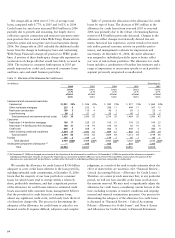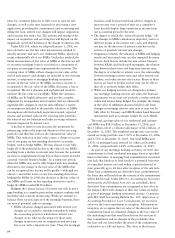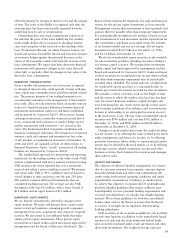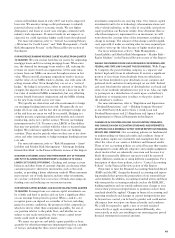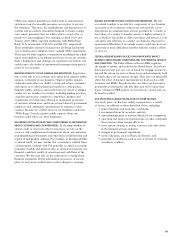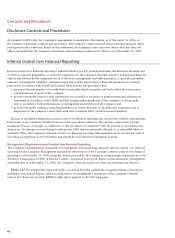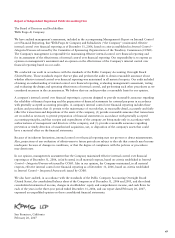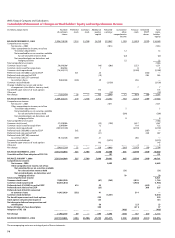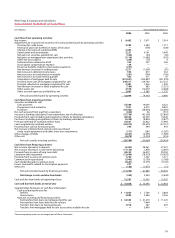Wells Fargo 2006 Annual Report Download - page 66
Download and view the complete annual report
Please find page 66 of the 2006 Wells Fargo annual report below. You can navigate through the pages in the report by either clicking on the pages listed below, or by using the keyword search tool below to find specific information within the annual report.
64
ACQUISITIONS COULD REDUCE OUR STOCK PRICE UPON ANNOUNCEMENT
AND REDUCE OUR EARNINGS IF WE OVERPAY OR HAVE DIFFICULTY
INTEGRATING THEM. We regularly explore opportunities to acquire
companies in the financial services industry. We cannot predict the
frequency, size or timing of our acquisitions, and we typically do
not comment publicly on a possible acquisition until we have signed
a definitive agreement. When we do announce an acquisition,
our stock price may fall depending on the size of the acquisition
and the purchase price. It is also possible that an acquisition
could dilute earnings per share.
We generally must receive federal regulatory approval before
we can acquire a bank or bank holding company. In deciding
whether to approve a proposed bank acquisition, federal bank
regulators will consider, among other factors, the effect of the
acquisition on competition, financial condition, and future
prospects including current and projected capital ratios and
levels, the competence, experience, and integrity of management
and record of compliance with laws and regulations, the conve-
nience and needs of the communities to be served, including
the acquiring institution’s record of compliance under the
Community Reinvestment Act, and the effectiveness of the
acquiring institution in combating money laundering. Also, we
cannot be certain when or if, or on what terms and conditions,
any required regulatory approvals will be granted. We might
be required to sell banks, branches and/or business units as a
condition to receiving regulatory approval.
Difficulty in integrating an acquired company may cause us
not to realize expected revenue increases, cost savings, increases
in geographic or product presence, and other projected benefits
from the acquisition. The integration could result in higher than
expected deposit attrition (run-off), loss of key employees, dis-
ruption of our business or the business of the acquired company,
or otherwise harm our ability to retain customers and employees
or achieve the anticipated benefits of the acquisition. Time and
resources spent on integration may also impair our ability to
grow our existing businesses. Also, the negative effect of any
divestitures required by regulatory authorities in acquisitions
or business combinations may be greater than expected.
FEDERAL AND STATE REGULATIONS CAN RESTRICT OUR BUSINESS, AND
NON-COMPLIANCE COULD RESULT IN PENALTIES, LITIGATION AND DAMAGE
TO OUR REPUTATION. Our parent company, our subsidiary banks
and many of our nonbank subsidiaries are heavily regulated
at the federal and/or state levels. This regulation is to protect
depositors, federal deposit insurance funds, consumers and the
banking system as a whole, not our stockholders. Federal and
state regulations can significantly restrict our businesses, and we
could be fined or otherwise penalized if we are found to be out
of compliance.
Recent high-profile corporate scandals and other events have
resulted in additional regulations. For example, Sarbanes-Oxley
limits the types of non-audit services our outside auditors may
provide to us in order to preserve the independence of our auditors
from us. If our auditors were found not to be “independent” of us
under SEC rules, we could be required to engage new auditors
and file new financial statements and audit reports with the SEC.
We could be out of compliance with SEC rules until new financial
statements and audit reports were filed, limiting our ability to
raise capital and resulting in other adverse consequences.
Sarbanes-Oxley also requires our management to evaluate
the Company’s disclosure controls and procedures and its inter-
nal control over financial reporting and requires our auditors to
issue a report on our internal control over financial reporting.
We are required to disclose, in our annual report on Form 10-K
filed with the SEC, the existence of any “material weaknesses”
in our internal control. We cannot assure that we will not find
one or more material weaknesses as of the end of any given year,
nor can we predict the effect on our stock price of disclosure of
a material weakness.
The Patriot Act, which was enacted in the wake of the
September 2001 terrorist attacks, requires us to implement new
or revised policies and procedures relating to anti-money laun-
dering, compliance, suspicious activities, and currency transac-
tion reporting and due diligence on customers. The Patriot Act
also requires federal bank regulators to evaluate the effectiveness
of an applicant in combating money laundering in determining
whether to approve a proposed bank acquisition.
A number of states have recently challenged the position of
the OCC as the sole regulator of national banks and their sub-
sidiaries. If these challenges are successful or if Congress acts to
give greater effect to state regulation, the impact on us could be
significant, not only because of the potential additional restric-
tions on our businesses but also from having to comply with
potentially 50 different sets of regulations.
From time to time Congress considers legislation that could
significantly change our regulatory environment, potentially
increasing our cost of doing business, limiting the activities we
may pursue or affecting the competitive balance among banks,
savings associations, credit unions, and other financial institu-
tions. As an example, our business model depends on sharing
information among the family of Wells Fargo businesses to bet-
ter satisfy our customers’ needs. Laws that restrict the ability of
our companies to share information about customers could limit
our ability to cross-sell products and services, reducing our rev-
enue and earnings.
For more information, refer to “Regulation and Supervision”
in our 2006 Form 10-K and to “Report of Independent
Registered Public Accounting Firm” in this Report.
WE MAY INCUR FINES, PENALTIES AND OTHER NEGATIVE CONSEQUENCES
FROM REGULATORY VIOLATIONS, POSSIBLY EVEN INADVERTENT OR
UNINTENTIONAL VIOLATIONS. We maintain systems and procedures
designed to ensure that we comply with applicable laws and
regulations. However, some legal/regulatory frameworks provide
for the imposition of fines or penalties for noncompliance even
though the noncompliance was inadvertent or unintentional and
even though there was in place at the time systems and proce-
dures designed to ensure compliance. For example, we are sub-
ject to regulations issued by the Office of Foreign Assets Control
(OFAC) that prohibit financial institutions from participating in
the transfer of property belonging to the governments of certain
foreign countries and designated nationals of those countries.


